Harbingers of Hope: How Sea Turtles Are Indicators of Ocean Health

Tin
5
min. read
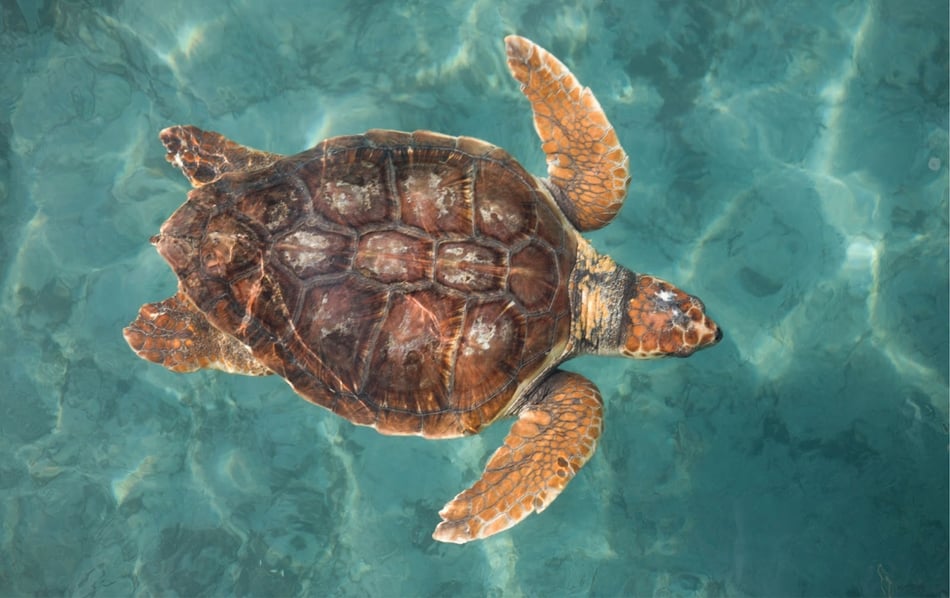
Sea turtles are often celebrated as travelers of the ocean, easily recognized by their streamlined shells and flippers. Their iconic status in marine lore and real-world conservation efforts has made them beloved figures, yet many of us know little about their ecological significance - even though they serve vital roles in maintaining the health and balance of marine ecosystems.
Below we delve into the often-overlooked but crucial ecological roles that these ancient beings have played in our oceans.
Below we delve into the often-overlooked but crucial ecological roles that these ancient beings have played in our oceans.
Types of Sea Turtles
When we talk about sea turtles, we're actually referring to a diverse group of species, each with its own unique characteristics and preferred habitats. Here are just a few of the most well-known types of sea turtles:

Loggerhead
Known for their large heads and strong jaws, Loggerhead turtles are often found in the Atlantic, Pacific, and Indian Oceans. They prefer coastal habitats like estuaries and bays where they can easily access their favorite foods like crabs and other shellfish.
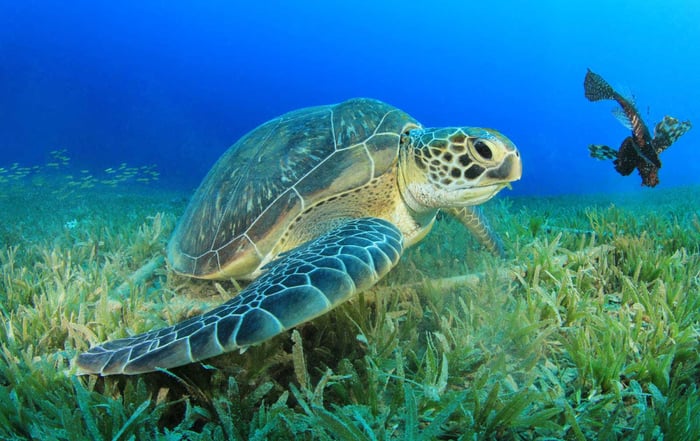
Green Sea Turtle
Despite the name, green sea turtles are not actually green; the name comes from the color of their fat. They are primarily found in tropical and subtropical waters and are unique for their mostly herbivorous diet, munching on seagrass and algae.
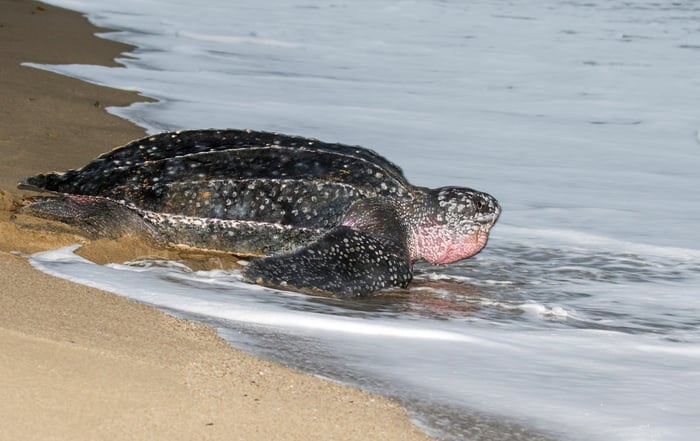
Leatherback
The Leatherback is the heavyweight champion among sea turtles, being the largest and heaviest of them all. Unlike other sea turtles, Leatherbacks have a soft, leathery shell. They're wanderers and are often found in open seas, traversing both warm and cold waters to feed on jellyfish.
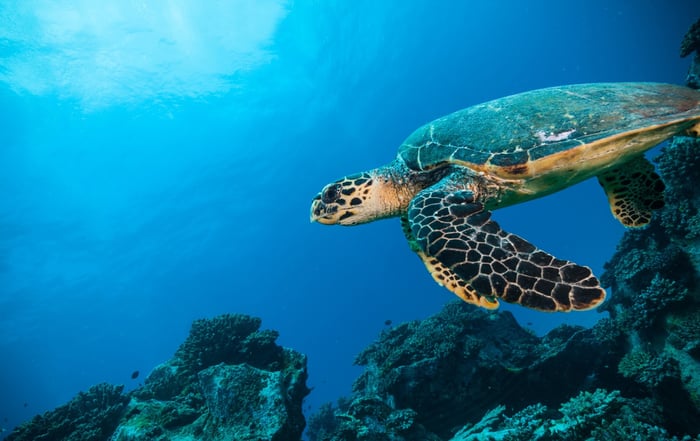
Hawksbill
Recognizable by their pointed beaks and striking shell patterns, Hawksbills generally inhabit tropical waters, frequenting coral reefs where they feed on sponges.
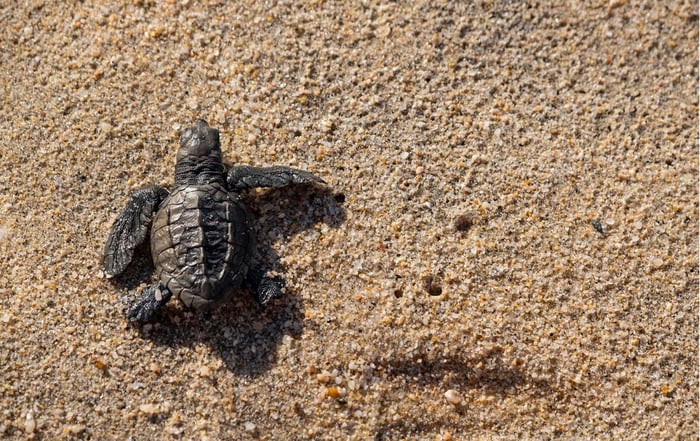
Olive Ridley
These are the smallest and most abundant of sea turtles. Found mainly in warm tropical waters, Olive Ridleys are known for their synchronized nesting in mass numbers, often referred to as "arribadas."
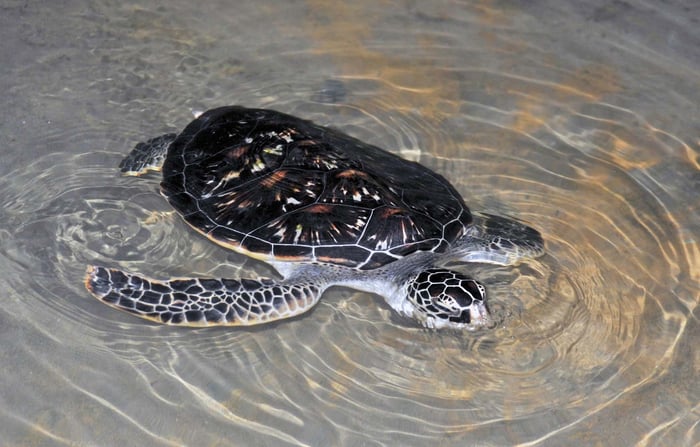
Kemp’s Ridley
The most endangered of all sea turtles, Kemp's Ridleys prefer the Gulf of Mexico and the East Coast of the United States. They also practice mass nesting and enjoy feasting on crabs.
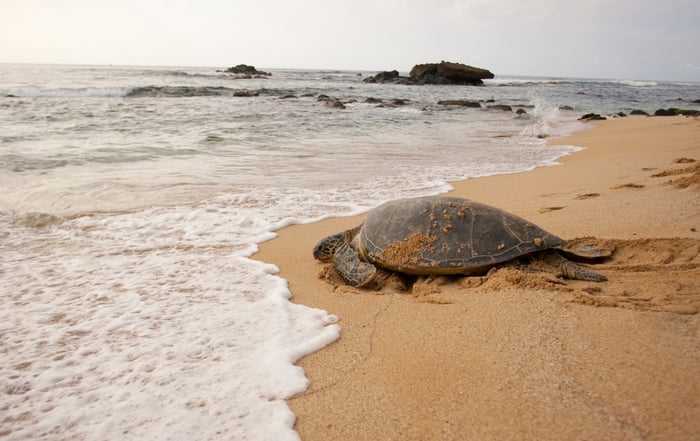
Flatback
Native to the waters around Australia and Papua New Guinea, Flatbacks are named for their flat shells. They are generally found in continental shelf areas and coastal waters where they feed on a varied diet including sea cucumbers and jellyfish.
Ecological Impacts of Sea Turtles
Each of the species mentioned above - as well as the numerous other types of sea turtles not mentioned - occupies a distinct niche, contributing in its own way to the vitality of marine ecosystems. Below are several ways in which all of these turtles affect ecosystems and impact marine environments.
Nutrient Distribution and Migratory Impact
Sea turtles are vital components of marine ecosystems, not just for their role as grazers or predators, but also as agents of nutrient distribution. Their wide-ranging migratory patterns help transport essential nutrients across vast expanses of ocean. For instance, as they travel, they excrete waste that becomes part of the nutrient cycle, benefitting various marine life forms along their path.
Moreover, their nesting behavior plays a critical role in nutrient distribution on land. Female sea turtles return to their natal beaches to lay eggs. The eggs themselves, as well as the unhatched or unviable ones left behind, release vital nutrients like nitrogen and phosphorus into the sand. This not only enriches the soil but also promotes vegetation growth, which in turn helps in stabilizing the beach environment.
Moreover, their nesting behavior plays a critical role in nutrient distribution on land. Female sea turtles return to their natal beaches to lay eggs. The eggs themselves, as well as the unhatched or unviable ones left behind, release vital nutrients like nitrogen and phosphorus into the sand. This not only enriches the soil but also promotes vegetation growth, which in turn helps in stabilizing the beach environment.
By linking the oceans with land in this cyclical way, sea turtles act as important connectors and nutrient distributors in their ecosystems.
Sea Turtles as Jellyfish Predators
Leatherback sea turtles have a unique role in marine ecosystems as one of the few natural predators of jellyfish. These turtles consume significant quantities of jellyfish, helping to keep their populations in check.
This control is crucial because jellyfish, when abundant, can disrupt the marine food web by consuming large amounts of plankton. Plankton serves as the primary food source for various small fish and other marine creatures, which in turn are prey for larger species.
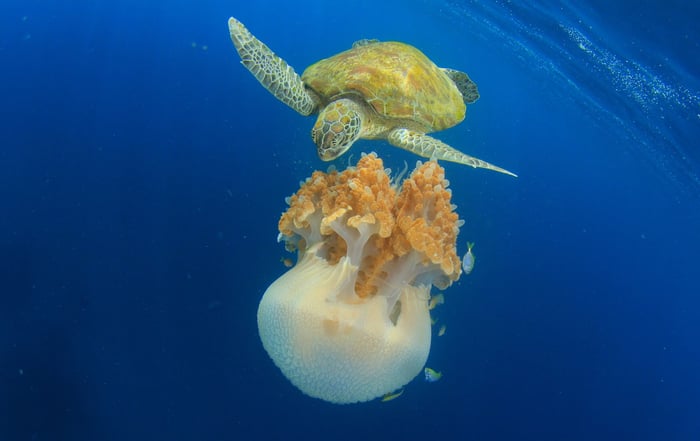
A surge in jellyfish populations can, therefore, result in a decline in plankton, disrupting the balance and flow of energy through the ecosystem.
By feeding on jellyfish, Leatherbacks play a pivotal role in maintaining the equilibrium of marine food webs. Their predation helps prevent the overpopulation of jellyfish, ensuring a more balanced distribution of resources and promoting overall oceanic health.
Indicators of Marine Health
Sea turtles serve as a valuable indicator species for the overall health of marine ecosystems. Their well-being often reflects the condition of the habitat they reside in, including the quality of the water and the availability of food sources like seagrass and jellyfish.
Sea turtles occupy multiple marine habitats during their life cycle, including open ocean, coastal areas, and coral reefs. Therefore, a decline in sea turtle populations can signify issues ranging from water pollution and habitat destruction to imbalances in the food web.
The presence of healthy sea turtles can indicate well-functioning ecosystems with balanced predator-prey relationships. For example, green turtles graze on seagrasses, effectively pruning them, which helps the seagrass beds to remain productive and provide habitat for other species. Conversely, when sea turtles are sick or declining in number, this can be a red flag for environmental issues such as water pollution, overfishing, or the presence of harmful algal blooms.
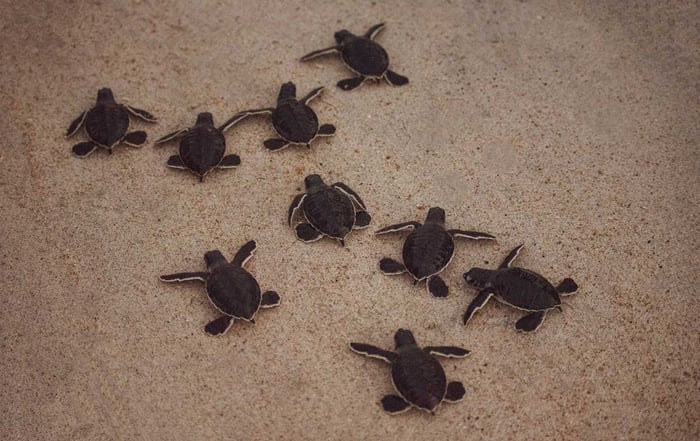
Sea turtles are also affected by incidental capture in fishing gear, known as bycatch. Therefore, monitoring sea turtle populations can offer insights into the impact of human activities like fishing, shipping, and even coastal development.
Moreover, because sea turtles migrate vast distances, they interact with multiple ecosystems. A decline noted in one region could signify environmental stresses that are much more widespread, perhaps global. This migratory behavior makes them excellent candidates for assessing the health of the ocean at large.
A thriving sea turtle population is often indicative of a healthy marine ecosystem, while declining numbers can serve as a warning signal necessitating further investigation and potential conservation action.
Why We Love Sea Turtles
Sea turtles are far more than just iconic creatures of the ocean; they are vital cogs in the marine ecosystem. These beautiful marine creatures contribute to maintaining a balanced marine environment, and their status serves as a barometer for the overall health of the ocean, making their conservation an issue that should concern us all.
At IMARCS, we share a deep appreciation for these magnificent creatures and their role in our marine ecosystems. Our vision and mission encompass the preservation of marine life, making it our duty to safeguard the habitats that various species and creatures rely on. By pioneering innovative mariculture solutions, we work to restore the balance of marine ecosystems, ensuring that sea turtles, and countless other species, continue to thrive in a healthy and resilient ocean environment. While our work is currently focused mainly on giant clams and their positive impacts on marine ecosystems and carbon mitigation, we encourage supporting sea turtle rescue programs or any projects that safeguard these magnificent creatures. Every bit of support helps ensure a thriving marine ecosystem for all.
References:
Bouchard, S. S., & Bjorndal, K. A. (2000). Sea turtles as biological transporters of nutrients and energy from marine to terrestrial ecosystems. Ecology, 81(8), 2305. https://doi.org/10.2307/177116
Green turtle. (n.d.). World Wildlife Fund. Retrieved September 4, 2023, from https://www.worldwildlife.org/species/green-turtle
Hawksbill sea turtle. (n.d.). National Wildlife Federation. Retrieved September 4, 2023, from https://www.nwf.org/Educational-Resources/Wildlife-Guide/Reptiles/Sea-Turtles/Hawksbill-Sea-Turtle
Leatherback turtle —. (n.d.). SEE Turtles. Retrieved September 4, 2023, from https://www.seeturtles.org/leatherback-turtle
Leatherback sea turtle. (n.d.). National Wildlife Federation. Retrieved September 4, 2023, from https://www.nwf.org/Educational-Resources/Wildlife-Guide/Reptiles/Sea-Turtles/Leatherback-Sea-Turtle
Radley, C. (2017, February 9). Inside of a sea turtle’s mouth. Sea Turtle Exploration | Learning with Sea Turtles by the North Carolina Aquarium at Fort Fisher; Sea Turtle Exploration. https://seaturtleexploration.com/inside-of-a-sea-turtles-mouth/
Sea turtles 101. (2019, February 6). National Geographic. https://www.nationalgeographic.com/animals/reptiles/facts/kemps-ridley-sea-turtle
Smith, R. A. (2020, July 17). The sea Turtle - A great indicator of sea health. Plastic Oceans International. https://plasticoceans.org/sea-turtles-the-greatest-indicators-of-the-state-of-our-oceans/
Why Oceans Need Sea Turtles: The Importance of Sea Turtles in Marine Ecosystems. (n.d.). Oceana.org. Retrieved September 4, 2023, from https://oceana.org/wp-content/uploads/sites/18/Why_Healthy_Oceans_Need_Sea_Turtles.pdf
Aguirre, A. A., & Tabor, G. (2004). Introduction: Marine vertebrates as sentinels of marine ecosystem health. EcoHealth, 1(3). https://doi.org/10.1007/s10393-004-0091-9
Bouchard, S. S., & Bjorndal, K. A. (2000). Sea turtles as biological transporters of nutrients and energy from marine to terrestrial ecosystems. Ecology, 81(8), 2305. https://doi.org/10.2307/177116
Green turtle. (n.d.). World Wildlife Fund. Retrieved September 4, 2023, from https://www.worldwildlife.org/species/green-turtle
Hawksbill sea turtle. (n.d.). National Wildlife Federation. Retrieved September 4, 2023, from https://www.nwf.org/Educational-Resources/Wildlife-Guide/Reptiles/Sea-Turtles/Hawksbill-Sea-Turtle
Heaslip, S. G., Iverson, S. J., Bowen, W. D., & James, M. C. (2012). Jellyfish support high energy intake of leatherback sea turtles (dermochelys coriacea): Video evidence from animal-borne cameras. PloS One, 7(3), e33259. https://doi.org/10.1371/journal.pone.0033259
Leatherback turtle —. (n.d.). SEE Turtles. Retrieved September 4, 2023, from https://www.seeturtles.org/leatherback-turtle
Leatherback sea turtle. (n.d.). National Wildlife Federation. Retrieved September 4, 2023, from https://www.nwf.org/Educational-Resources/Wildlife-Guide/Reptiles/Sea-Turtles/Leatherback-Sea-Turtle
Radley, C. (2017, February 9). Inside of a sea turtle’s mouth. Sea Turtle Exploration | Learning with Sea Turtles by the North Carolina Aquarium at Fort Fisher; Sea Turtle Exploration. https://seaturtleexploration.com/inside-of-a-sea-turtles-mouth/
Sea turtles 101. (2019, February 6). National Geographic. https://www.nationalgeographic.com/animals/reptiles/facts/kemps-ridley-sea-turtle
Smith, R. A. (2020, July 17). The sea Turtle - A great indicator of sea health. Plastic Oceans International. https://plasticoceans.org/sea-turtles-the-greatest-indicators-of-the-state-of-our-oceans/
Why Oceans Need Sea Turtles: The Importance of Sea Turtles in Marine Ecosystems. (n.d.). Oceana.org. Retrieved September 4, 2023, from https://oceana.org/wp-content/uploads/sites/18/Why_Healthy_Oceans_Need_Sea_Turtles.pdf
Why are sea turtles important — SEE turtles —. (n.d.). SEE Turtles. Retrieved September 4, 2023, from https://www.seeturtles.org/why-are-sea-turtles-important